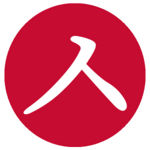Difference between revisions of "Hangeul step 3/nl"
DigitalSoju (Talk | contribs) |
Marc Wentink (Talk | contribs) |
||
| (11 intermediate revisions by 3 users not shown) | |||
| Line 3: | Line 3: | ||
{| border=0 style="text-align:center; margin-left: auto; margin-right: auto;" | {| border=0 style="text-align:center; margin-left: auto; margin-right: auto;" | ||
|- | |- | ||
| − | | [[File: | + | | [[File:Vorige.png|link=Hangeul step 2/nl|150px]] |
| − | | [[File: | + | | [[File:Volgende.png|link=Hangeul step 3b/nl|150px]] |
|} | |} | ||
| − | In | + | In deze les leer je: |
| − | * | + | *Medeklinkers: [[ㅅ]], [[ㅂ]], [[ㅈ]], [[ㄹ]] |
| − | * | + | *Klinkers: [[ㅐ]], [[ㅔ]], [[ㅓ]], [[ㅡ]] |
{{Hangeul intro table/nl | {{Hangeul intro table/nl | ||
| Line 15: | Line 15: | ||
|Consonant = ㅅ | |Consonant = ㅅ | ||
|Cons image = ㅅ.jpg | |Cons image = ㅅ.jpg | ||
| − | |Cons text = | + | |Cons text = Deze klinkt als een /s/. In combinatie met de klinkers [[ㅣ]], [[ㅕ]], [[ㅑ]], [[ㅠ]], [[ㅛ]] wordt hij uitgesproken als "sj". We hebben de laatste vier klinkers nog niet besproken, dus onthoud voorlopig alleen dat een ㅅ gevolgd door een ㅣ klinkt als het Engelse woord "she". We gaan er verder op in als je de andere klinkers leert. Zie voor de volledige informatie over deze letter [[ㅅ]]. |
|Vowel = ㅐ | |Vowel = ㅐ | ||
|Vowel image = ㅐ.jpg | |Vowel image = ㅐ.jpg | ||
| − | |Vowel text = | + | |Vowel text = Klinkt als de "e" in werk. Zie voor de volledige informatie over deze letter [[ㅐ]]. |
| − | |Vowel audio description1 = | + | |Vowel audio description1 = Jongen |
|Vowel audio1 = <flashmp3>ae H.mp3|leftbg=003478|rightbg=c60c30|lefticon=ffffff|righticon=ffffff</flashmp3> | |Vowel audio1 = <flashmp3>ae H.mp3|leftbg=003478|rightbg=c60c30|lefticon=ffffff|righticon=ffffff</flashmp3> | ||
| − | |Vowel audio description2 = | + | |Vowel audio description2 = Meisje |
|Vowel audio2 = <flashmp3>ae M.mp3|leftbg=003478|rightbg=c60c30|lefticon=ffffff|righticon=ffffff</flashmp3> | |Vowel audio2 = <flashmp3>ae M.mp3|leftbg=003478|rightbg=c60c30|lefticon=ffffff|righticon=ffffff</flashmp3> | ||
}} | }} | ||
| Line 27: | Line 27: | ||
{| class="wikitable" style="text-align:center; margin-left: auto; margin-right: auto;font-size:300%;" | {| class="wikitable" style="text-align:center; margin-left: auto; margin-right: auto;font-size:300%;" | ||
|-style="font-size:70%" | |-style="font-size:70%" | ||
| − | !colspan="2"| | + | !colspan="2"|Oefening |
|- | |- | ||
| 새 | | 새 | ||
| Line 38: | Line 38: | ||
|Consonant = ㅂ | |Consonant = ㅂ | ||
|Cons image = ㅂ.jpg | |Cons image = ㅂ.jpg | ||
| − | |Cons text = | + | |Cons text = Deze letter spreek je aan het begin van een woord uit als een klank die tussen de B en de P in zit. Als hij echter tussen twee klinkers staat, wordt hij stemhebbend als een /b/. Zie voor de volledige informatie over deze letter [[ㅂ]]. |
|Vowel = ㅔ | |Vowel = ㅔ | ||
|Vowel image = ㅔ.jpg | |Vowel image = ㅔ.jpg | ||
| − | |Vowel text = | + | |Vowel text = Deze werd ooit anders uitgesproken dan de ㅐ, maar tegenwoordig is er niet echt meer een onderscheid, hoewel je hem soms iets minder lang aanhoudt dan de ㅐ. Hij lijkt op de "e" van "vreemd", maar dan korter uitgesproken. Zie voor de volledige informatie over deze letter [[ㅔ]]. |
| − | |Vowel audio description1 = | + | |Vowel audio description1 = Jongen |
|Vowel audio1 = <flashmp3>e H.mp3|leftbg=003478|rightbg=c60c30|lefticon=ffffff|righticon=ffffff</flashmp3> | |Vowel audio1 = <flashmp3>e H.mp3|leftbg=003478|rightbg=c60c30|lefticon=ffffff|righticon=ffffff</flashmp3> | ||
| − | |Vowel audio description2 = | + | |Vowel audio description2 = Meisje |
|Vowel audio2 = <flashmp3>e M.mp3|leftbg=003478|rightbg=c60c30|lefticon=ffffff|righticon=ffffff</flashmp3> | |Vowel audio2 = <flashmp3>e M.mp3|leftbg=003478|rightbg=c60c30|lefticon=ffffff|righticon=ffffff</flashmp3> | ||
}} | }} | ||
| Line 51: | Line 51: | ||
{| class="wikitable" style="text-align:center; margin-left: auto; margin-right: auto;font-size:300%;" | {| class="wikitable" style="text-align:center; margin-left: auto; margin-right: auto;font-size:300%;" | ||
|-style="font-size:70%" | |-style="font-size:70%" | ||
| − | !colspan="2"| | + | !colspan="2"|Oefening |
|- | |- | ||
| 베 | | 베 | ||
| Line 69: | Line 69: | ||
|Consonant = ㅈ | |Consonant = ㅈ | ||
|Cons image = ㅈ.jpg | |Cons image = ㅈ.jpg | ||
| − | |Cons text = | + | |Cons text = Deze letter spreek je aan het begin van een woord uit als een klank die tussen 'dzj' of /j/ en 'tjs' of /ch/ in zit. Als hij echter tussen twee klinkers in staat, wordt hij stemhebbend en ''lijkt'' hij op /j/, maar '''klinkt niet precies hetzelfde. Er is een klein verschil. Zie voor de volledige informatie over deze letter [[ㅈ]]. |
|Vowel = ㅓ | |Vowel = ㅓ | ||
|Vowel image = ㅓ.jpg | |Vowel image = ㅓ.jpg | ||
| − | |Vowel text = | + | |Vowel text = Deze klank lijkt op de korte o in bos, maar dan een beetje langer aangehouden zoals de 오 die je al geleerd hebt. Luister heel goed naar het geluidsbestand! Zie voor de volledige informatie over deze letter [[ㅓ]]. |
| − | |Vowel audio description1 = | + | |Vowel audio description1 = Jongen |
|Vowel audio1 = <flashmp3>eo H.mp3|leftbg=003478|rightbg=c60c30|lefticon=ffffff|righticon=ffffff</flashmp3> | |Vowel audio1 = <flashmp3>eo H.mp3|leftbg=003478|rightbg=c60c30|lefticon=ffffff|righticon=ffffff</flashmp3> | ||
| − | |Vowel audio description2 = | + | |Vowel audio description2 = Meisje |
|Vowel audio2 = <flashmp3>eo M.mp3|leftbg=003478|rightbg=c60c30|lefticon=ffffff|righticon=ffffff</flashmp3> | |Vowel audio2 = <flashmp3>eo M.mp3|leftbg=003478|rightbg=c60c30|lefticon=ffffff|righticon=ffffff</flashmp3> | ||
}} | }} | ||
| Line 81: | Line 81: | ||
{| class="wikitable" style="text-align:center; margin-left: auto; margin-right: auto;font-size:300%;" | {| class="wikitable" style="text-align:center; margin-left: auto; margin-right: auto;font-size:300%;" | ||
|-style="font-size:70%" | |-style="font-size:70%" | ||
| − | !colspan="2"| | + | !colspan="2"|Oefening |
|- | |- | ||
| 저 | | 저 | ||
| Line 105: | Line 105: | ||
|Consonant = ㄹ | |Consonant = ㄹ | ||
|Cons image = ㄹ.jpg | |Cons image = ㄹ.jpg | ||
| − | |Cons text = | + | |Cons text = Deze letter kun je als een R of als een L uitspreken. Als eerste letter zit de klank soms tussen die van de R en de L in, behalve in Westerse leenwoorden met een R-klank. Let op dat dit niet een typisch Nederlandse /r/ is, maar een tong R met een enkele slag. Hij klinkt als de D in het Engelse 'rider' of de dubbele T in het Engelse 'better'. Hij lijkt op de Spaanse R in het woord 'caro.' Zie voor de volledige informatie over deze letter [[ㄹ]]. |
|Vowel = ㅡ | |Vowel = ㅡ | ||
|Vowel image = ㅡ.jpg | |Vowel image = ㅡ.jpg | ||
| − | |Vowel text = | + | |Vowel text = Er is geen Nederlandse klank om de ㅡ mee te vergelijken, dus luister heel goed naar het geluidsbestand. Het lijkt een beetje op de uitspraak van freule. Zie voor de volledige informatie over deze letter [[ㅡ]]. |
| − | |Vowel audio description1 = | + | |Vowel audio description1 = Jongen |
|Vowel audio1 = <flashmp3>eu H.mp3|leftbg=003478|rightbg=c60c30|lefticon=ffffff|righticon=ffffff</flashmp3> | |Vowel audio1 = <flashmp3>eu H.mp3|leftbg=003478|rightbg=c60c30|lefticon=ffffff|righticon=ffffff</flashmp3> | ||
| − | |Vowel audio description2 = | + | |Vowel audio description2 = Meisje |
|Vowel audio2 = <flashmp3>eu M.mp3|leftbg=003478|rightbg=c60c30|lefticon=ffffff|righticon=ffffff</flashmp3> | |Vowel audio2 = <flashmp3>eu M.mp3|leftbg=003478|rightbg=c60c30|lefticon=ffffff|righticon=ffffff</flashmp3> | ||
}} | }} | ||
| Line 117: | Line 117: | ||
{| class="wikitable" style="text-align:center; margin-left: auto; margin-right: auto;font-size:300%;" | {| class="wikitable" style="text-align:center; margin-left: auto; margin-right: auto;font-size:300%;" | ||
|-style="font-size:70%" | |-style="font-size:70%" | ||
| − | !colspan="2"| | + | !colspan="2"|Oefening |
|- | |- | ||
| 르 | | 르 | ||
| Line 142: | Line 142: | ||
| − | == | + | ==Echte voorbeelden== |
| − | + | Oefen met deze echte Koreaanse woorden. De voorbeelden voor stap 3 zijn opgesplitst. De helft van de voorbeelden staan hier en de andere helft op de volgende pagina. | |
| − | * | + | *Tot nu toe geleerde medeklinkers: [[ㄱ]], [[ㄴ]], [[ㅁ]], [[ㄷ]], [[ㅇ]], [[ㅅ]], [[ㅂ]], [[ㅈ]], [[ㄹ]] |
| − | * | + | *Tot nu toe geleerde klinkers: [[ㅏ]], [[ㅜ]], [[ㅗ]], [[ㅣ]], [[ㅐ]], [[ㅔ]], [[ㅓ]], [[ㅡ]] |
{| class="wikitable" style="text-align:center; margin-left: auto; margin-right: auto;" | {| class="wikitable" style="text-align:center; margin-left: auto; margin-right: auto;" | ||
|- | |- | ||
| − | ! | + | ! Woord !! Audio |
|- | |- | ||
| − | | 가게 ( | + | | 가게 (winkel) |
| <flashmp3>gage H.mp3, gage M.mp3|leftbg=003478|rightbg=c60c30|lefticon=ffffff|righticon=ffffff|loop=yes</flashmp3> | | <flashmp3>gage H.mp3, gage M.mp3|leftbg=003478|rightbg=c60c30|lefticon=ffffff|righticon=ffffff|loop=yes</flashmp3> | ||
|- | |- | ||
| − | | 가로 ( | + | | 가로 (breedte) |
| <flashmp3>garo H.mp3, garo M.mp3|leftbg=003478|rightbg=c60c30|lefticon=ffffff|righticon=ffffff|loop=yes</flashmp3> | | <flashmp3>garo H.mp3, garo M.mp3|leftbg=003478|rightbg=c60c30|lefticon=ffffff|righticon=ffffff|loop=yes</flashmp3> | ||
|- | |- | ||
| − | | 가로수 ( | + | | 가로수 (bomen langs een laan) |
| <flashmp3>garosu H.mp3, garosu M.mp3|leftbg=003478|rightbg=c60c30|lefticon=ffffff|righticon=ffffff|loop=yes</flashmp3> | | <flashmp3>garosu H.mp3, garosu M.mp3|leftbg=003478|rightbg=c60c30|lefticon=ffffff|righticon=ffffff|loop=yes</flashmp3> | ||
|- | |- | ||
| − | | 가르마 ( | + | | 가르마 (haarscheiding) |
| <flashmp3>gareuma H.mp3, gareuma M.mp3|leftbg=003478|rightbg=c60c30|lefticon=ffffff|righticon=ffffff|loop=yes</flashmp3> | | <flashmp3>gareuma H.mp3, gareuma M.mp3|leftbg=003478|rightbg=c60c30|lefticon=ffffff|righticon=ffffff|loop=yes</flashmp3> | ||
|- | |- | ||
| − | | 가사 ( | + | | 가사 (songtekst) |
| <flashmp3>gasa H.mp3,gasa M.mp3|leftbg=003478|rightbg=c60c30|lefticon=ffffff|righticon=ffffff|loop=yes</flashmp3> | | <flashmp3>gasa H.mp3,gasa M.mp3|leftbg=003478|rightbg=c60c30|lefticon=ffffff|righticon=ffffff|loop=yes</flashmp3> | ||
|- | |- | ||
| − | | 가수 ( | + | | 가수 (zanger) |
| <flashmp3>gasu H.mp3, gasu M.mp3|leftbg=003478|rightbg=c60c30|lefticon=ffffff|righticon=ffffff|loop=yes</flashmp3> | | <flashmp3>gasu H.mp3, gasu M.mp3|leftbg=003478|rightbg=c60c30|lefticon=ffffff|righticon=ffffff|loop=yes</flashmp3> | ||
|- | |- | ||
| Line 172: | Line 172: | ||
| <flashmp3>gaseu H.mp3, gaseu M.mp3|leftbg=003478|rightbg=c60c30|lefticon=ffffff|righticon=ffffff|loop=yes</flashmp3> | | <flashmp3>gaseu H.mp3, gaseu M.mp3|leftbg=003478|rightbg=c60c30|lefticon=ffffff|righticon=ffffff|loop=yes</flashmp3> | ||
|- | |- | ||
| − | | 가루 ( | + | | 가루 (poeder) |
| <flashmp3>garu H.mp3, garu M.mp3|leftbg=003478|rightbg=c60c30|lefticon=ffffff|righticon=ffffff|loop=yes</flashmp3> | | <flashmp3>garu H.mp3, garu M.mp3|leftbg=003478|rightbg=c60c30|lefticon=ffffff|righticon=ffffff|loop=yes</flashmp3> | ||
|- | |- | ||
| − | | 개 ( | + | | 개 (hond) |
| <flashmp3>gae H.mp3, gae M.mp3|leftbg=003478|rightbg=c60c30|lefticon=ffffff|righticon=ffffff|loop=yes</flashmp3> | | <flashmp3>gae H.mp3, gae M.mp3|leftbg=003478|rightbg=c60c30|lefticon=ffffff|righticon=ffffff|loop=yes</flashmp3> | ||
|- | |- | ||
| − | | 개미 ( | + | | 개미 (mier) |
| <flashmp3>gaemi H.mp3, gaemi M.mp3|leftbg=003478|rightbg=c60c30|lefticon=ffffff|righticon=ffffff|loop=yes</flashmp3> | | <flashmp3>gaemi H.mp3, gaemi M.mp3|leftbg=003478|rightbg=c60c30|lefticon=ffffff|righticon=ffffff|loop=yes</flashmp3> | ||
|- | |- | ||
| − | | 거기 ( | + | | 거기 (daar) |
| <flashmp3>geogi H.mp3, geogi M.mp3|leftbg=003478|rightbg=c60c30|lefticon=ffffff|righticon=ffffff|loop=yes</flashmp3> | | <flashmp3>geogi H.mp3, geogi M.mp3|leftbg=003478|rightbg=c60c30|lefticon=ffffff|righticon=ffffff|loop=yes</flashmp3> | ||
|- | |- | ||
| − | | 거리 ( | + | | 거리 (straat, afstand) |
| <flashmp3>geori H.mp3, geori M.mp3|leftbg=003478|rightbg=c60c30|lefticon=ffffff|righticon=ffffff|loop=yes</flashmp3> | | <flashmp3>geori H.mp3, geori M.mp3|leftbg=003478|rightbg=c60c30|lefticon=ffffff|righticon=ffffff|loop=yes</flashmp3> | ||
|- | |- | ||
| − | | 게 ( | + | | 게 (krab) |
| <flashmp3>ge H.mp3, ge M.mp3|leftbg=003478|rightbg=c60c30|lefticon=ffffff|righticon=ffffff|loop=yes</flashmp3> | | <flashmp3>ge H.mp3, ge M.mp3|leftbg=003478|rightbg=c60c30|lefticon=ffffff|righticon=ffffff|loop=yes</flashmp3> | ||
|- | |- | ||
| − | | 기내 ( | + | | 기내 (vliegcabine) |
| <flashmp3>gine H.mp3, gine M.mp3|leftbg=003478|rightbg=c60c30|lefticon=ffffff|righticon=ffffff|loop=yes</flashmp3> | | <flashmp3>gine H.mp3, gine M.mp3|leftbg=003478|rightbg=c60c30|lefticon=ffffff|righticon=ffffff|loop=yes</flashmp3> | ||
|- | |- | ||
| − | | 기다리다 ( | + | | 기다리다 (wachten) |
| <flashmp3>gidarida H.mp3, gidarida M.mp3|leftbg=003478|rightbg=c60c30|lefticon=ffffff|righticon=ffffff|loop=yes</flashmp3> | | <flashmp3>gidarida H.mp3, gidarida M.mp3|leftbg=003478|rightbg=c60c30|lefticon=ffffff|righticon=ffffff|loop=yes</flashmp3> | ||
|- | |- | ||
| − | | 고래 ( | + | | 고래 (walvis) |
| <flashmp3>gorae H.mp3, gorae M.mp3|leftbg=003478|rightbg=c60c30|lefticon=ffffff|righticon=ffffff|loop=yes</flashmp3> | | <flashmp3>gorae H.mp3, gorae M.mp3|leftbg=003478|rightbg=c60c30|lefticon=ffffff|righticon=ffffff|loop=yes</flashmp3> | ||
|- | |- | ||
| − | | 구조 ( | + | | 구조 (redding, hulp) |
| <flashmp3>gujo H.mp3, gujo M.mp3|leftbg=003478|rightbg=c60c30|lefticon=ffffff|righticon=ffffff|loop=yes</flashmp3> | | <flashmp3>gujo H.mp3, gujo M.mp3|leftbg=003478|rightbg=c60c30|lefticon=ffffff|righticon=ffffff|loop=yes</flashmp3> | ||
|- | |- | ||
| − | | 나라 ( | + | | 나라 (land) |
| <flashmp3>nara H.mp3, nara M.mp3|leftbg=003478|rightbg=c60c30|lefticon=ffffff|righticon=ffffff|loop=yes</flashmp3> | | <flashmp3>nara H.mp3, nara M.mp3|leftbg=003478|rightbg=c60c30|lefticon=ffffff|righticon=ffffff|loop=yes</flashmp3> | ||
|- | |- | ||
| − | | 나르다 ( | + | | 나르다 (dragen) |
| <flashmp3>nareuda H.mp3, nareuda M.mp3|leftbg=003478|rightbg=c60c30|lefticon=ffffff|righticon=ffffff|loop=yes</flashmp3> | | <flashmp3>nareuda H.mp3, nareuda M.mp3|leftbg=003478|rightbg=c60c30|lefticon=ffffff|righticon=ffffff|loop=yes</flashmp3> | ||
|- | |- | ||
| − | | 나이 ( | + | | 나이 (leeftijd) |
| <flashmp3>nai H.mp3, nai M.mp3|leftbg=003478|rightbg=c60c30|lefticon=ffffff|righticon=ffffff|loop=yes</flashmp3> | | <flashmp3>nai H.mp3, nai M.mp3|leftbg=003478|rightbg=c60c30|lefticon=ffffff|righticon=ffffff|loop=yes</flashmp3> | ||
|- | |- | ||
| − | | 나사 ( | + | | 나사 (schroef) |
| <flashmp3>nasa H.mp3, nasa M.mp3|leftbg=003478|rightbg=c60c30|lefticon=ffffff|righticon=ffffff|loop=yes</flashmp3> | | <flashmp3>nasa H.mp3, nasa M.mp3|leftbg=003478|rightbg=c60c30|lefticon=ffffff|righticon=ffffff|loop=yes</flashmp3> | ||
|- | |- | ||
| − | | 나비 ( | + | | 나비 (vlinder) |
| <flashmp3>nabi H.mp3, nabi M.mp3|leftbg=003478|rightbg=c60c30|lefticon=ffffff|righticon=ffffff|loop=yes</flashmp3> | | <flashmp3>nabi H.mp3, nabi M.mp3|leftbg=003478|rightbg=c60c30|lefticon=ffffff|righticon=ffffff|loop=yes</flashmp3> | ||
|- | |- | ||
| − | | 내리다 ( | + | | 내리다 (afdalen) |
| <flashmp3>naerida H.mp3, naerida M.mp3|leftbg=003478|rightbg=c60c30|lefticon=ffffff|righticon=ffffff|loop=yes</flashmp3> | | <flashmp3>naerida H.mp3, naerida M.mp3|leftbg=003478|rightbg=c60c30|lefticon=ffffff|righticon=ffffff|loop=yes</flashmp3> | ||
|- | |- | ||
| − | | 네 ( | + | | 네 (ja) |
| <flashmp3>ne H.mp3, ne M.mp3|leftbg=003478|rightbg=c60c30|lefticon=ffffff|righticon=ffffff|loop=yes</flashmp3> | | <flashmp3>ne H.mp3, ne M.mp3|leftbg=003478|rightbg=c60c30|lefticon=ffffff|righticon=ffffff|loop=yes</flashmp3> | ||
|- | |- | ||
| − | | 내 ( | + | | 내 (mijn) |
| <flashmp3>nae H.mp3, nae M.mp3|leftbg=003478|rightbg=c60c30|lefticon=ffffff|righticon=ffffff|loop=yes</flashmp3> | | <flashmp3>nae H.mp3, nae M.mp3|leftbg=003478|rightbg=c60c30|lefticon=ffffff|righticon=ffffff|loop=yes</flashmp3> | ||
|- | |- | ||
| − | | 네모 ( | + | | 네모 (vierkant) |
| <flashmp3>nemo H.mp3, nemo M.mp3|leftbg=003478|rightbg=c60c30|lefticon=ffffff|righticon=ffffff|loop=yes</flashmp3> | | <flashmp3>nemo H.mp3, nemo M.mp3|leftbg=003478|rightbg=c60c30|lefticon=ffffff|righticon=ffffff|loop=yes</flashmp3> | ||
|- | |- | ||
| − | | 너구리 ( | + | | 너구리 (wasbeer) |
| <flashmp3>neoguri H.mp3, neoguri M.mp3|leftbg=003478|rightbg=c60c30|lefticon=ffffff|righticon=ffffff|loop=yes</flashmp3> | | <flashmp3>neoguri H.mp3, neoguri M.mp3|leftbg=003478|rightbg=c60c30|lefticon=ffffff|righticon=ffffff|loop=yes</flashmp3> | ||
|- | |- | ||
| − | | 노루 ( | + | | 노루 (ree) |
| <flashmp3>noru H.mp3, noru M.mp3|leftbg=003478|rightbg=c60c30|lefticon=ffffff|righticon=ffffff|loop=yes</flashmp3> | | <flashmp3>noru H.mp3, noru M.mp3|leftbg=003478|rightbg=c60c30|lefticon=ffffff|righticon=ffffff|loop=yes</flashmp3> | ||
|- | |- | ||
| − | | 노래 ( | + | | 노래 (lied) |
| <flashmp3>norae H.mp3, norae M.mp3|leftbg=003478|rightbg=c60c30|lefticon=ffffff|righticon=ffffff|loop=yes</flashmp3> | | <flashmp3>norae H.mp3, norae M.mp3|leftbg=003478|rightbg=c60c30|lefticon=ffffff|righticon=ffffff|loop=yes</flashmp3> | ||
|- | |- | ||
| − | | 다리 ( | + | | 다리 (been, brug) |
| <flashmp3>dari H.mp3, dari M.mp3|leftbg=003478|rightbg=c60c30|lefticon=ffffff|righticon=ffffff|loop=yes</flashmp3> | | <flashmp3>dari H.mp3, dari M.mp3|leftbg=003478|rightbg=c60c30|lefticon=ffffff|righticon=ffffff|loop=yes</flashmp3> | ||
|- | |- | ||
| − | | 다시 ( | + | | 다시 (weer, opnieuw) |
| <flashmp3>dasi H.mp3, dasi M.mp3|leftbg=003478|rightbg=c60c30|lefticon=ffffff|righticon=ffffff|loop=yes</flashmp3> | | <flashmp3>dasi H.mp3, dasi M.mp3|leftbg=003478|rightbg=c60c30|lefticon=ffffff|righticon=ffffff|loop=yes</flashmp3> | ||
|- | |- | ||
| − | | 대구 (Daegu, | + | | 대구 (Daegu, de naam van een Koreaanse stad) |
| <flashmp3>daegu H.mp3, daegu M.mp3|leftbg=003478|rightbg=c60c30|lefticon=ffffff|righticon=ffffff|loop=yes</flashmp3> | | <flashmp3>daegu H.mp3, daegu M.mp3|leftbg=003478|rightbg=c60c30|lefticon=ffffff|righticon=ffffff|loop=yes</flashmp3> | ||
|- | |- | ||
| − | | 데우다 ( | + | | 데우다 (verhitten, opwarmen) |
| <flashmp3>deuda H.mp3, deuda M.mp3|leftbg=003478|rightbg=c60c30|lefticon=ffffff|righticon=ffffff|loop=yes</flashmp3> | | <flashmp3>deuda H.mp3, deuda M.mp3|leftbg=003478|rightbg=c60c30|lefticon=ffffff|righticon=ffffff|loop=yes</flashmp3> | ||
|- | |- | ||
| − | | 도마 ( | + | | 도마 (snijplank) |
| <flashmp3>doma H.mp3, doma M.mp3|leftbg=003478|rightbg=c60c30|lefticon=ffffff|righticon=ffffff|loop=yes</flashmp3> | | <flashmp3>doma H.mp3, doma M.mp3|leftbg=003478|rightbg=c60c30|lefticon=ffffff|righticon=ffffff|loop=yes</flashmp3> | ||
|- | |- | ||
| − | | 도시 ( | + | | 도시 (stad) |
| <flashmp3>dosi H.mp3, dosi M.mp3|leftbg=003478|rightbg=c60c30|lefticon=ffffff|righticon=ffffff|loop=yes</flashmp3> | | <flashmp3>dosi H.mp3, dosi M.mp3|leftbg=003478|rightbg=c60c30|lefticon=ffffff|righticon=ffffff|loop=yes</flashmp3> | ||
|- | |- | ||
| − | | 두부 ( | + | | 두부 (tofoe) |
| <flashmp3>dubu H.mp3, dubu M.mp3|leftbg=003478|rightbg=c60c30|lefticon=ffffff|righticon=ffffff|loop=yes</flashmp3> | | <flashmp3>dubu H.mp3, dubu M.mp3|leftbg=003478|rightbg=c60c30|lefticon=ffffff|righticon=ffffff|loop=yes</flashmp3> | ||
|- | |- | ||
| − | | 드디어 ( | + | | 드디어 (uiteindelijk) |
| <flashmp3>deudieo H.mp3, deudieo M.mp3|leftbg=003478|rightbg=c60c30|lefticon=ffffff|righticon=ffffff|loop=yes</flashmp3> | | <flashmp3>deudieo H.mp3, deudieo M.mp3|leftbg=003478|rightbg=c60c30|lefticon=ffffff|righticon=ffffff|loop=yes</flashmp3> | ||
|- | |- | ||
| Line 268: | Line 268: | ||
| <flashmp3>radio H.mp3, radio M.mp3|leftbg=003478|rightbg=c60c30|lefticon=ffffff|righticon=ffffff|loop=yes</flashmp3> | | <flashmp3>radio H.mp3, radio M.mp3|leftbg=003478|rightbg=c60c30|lefticon=ffffff|righticon=ffffff|loop=yes</flashmp3> | ||
|- | |- | ||
| − | | 러시아 ( | + | | 러시아 (Rusland) |
| <flashmp3>reosia H.mp3, reosia M.mp3|leftbg=003478|rightbg=c60c30|lefticon=ffffff|righticon=ffffff|loop=yes</flashmp3> | | <flashmp3>reosia H.mp3, reosia M.mp3|leftbg=003478|rightbg=c60c30|lefticon=ffffff|righticon=ffffff|loop=yes</flashmp3> | ||
|- | |- | ||
| − | | 마루 ( | + | | 마루 (houten vloer) |
| <flashmp3>maru H.mp3, maru M.mp3|leftbg=003478|rightbg=c60c30|lefticon=ffffff|righticon=ffffff|loop=yes</flashmp3> | | <flashmp3>maru H.mp3, maru M.mp3|leftbg=003478|rightbg=c60c30|lefticon=ffffff|righticon=ffffff|loop=yes</flashmp3> | ||
|- | |- | ||
| − | | 마리 ( | + | | 마리 (eenheid voor het tellen van dieren) |
| <flashmp3>mari H.mp3, mari M.mp3|leftbg=003478|rightbg=c60c30|lefticon=ffffff|righticon=ffffff|loop=yes</flashmp3> | | <flashmp3>mari H.mp3, mari M.mp3|leftbg=003478|rightbg=c60c30|lefticon=ffffff|righticon=ffffff|loop=yes</flashmp3> | ||
|- | |- | ||
| − | | 마르다 ( | + | | 마르다 (droog worden) |
| <flashmp3>mareuda H.mp3, mareuda M.mp3|leftbg=003478|rightbg=c60c30|lefticon=ffffff|righticon=ffffff|loop=yes</flashmp3> | | <flashmp3>mareuda H.mp3, mareuda M.mp3|leftbg=003478|rightbg=c60c30|lefticon=ffffff|righticon=ffffff|loop=yes</flashmp3> | ||
|- | |- | ||
| − | | 마시다 ( | + | | 마시다 (drinken) |
| − | | <flashmp3>masida H.mp3, | + | | <flashmp3>masida H.mp3, masida M.mp3|leftbg=003478|rightbg=c60c30|lefticon=ffffff|righticon=ffffff|loop=yes</flashmp3> |
|- | |- | ||
| − | | 머무르다 ( | + | | 머무르다 (verblijven) |
| <flashmp3>Meomuruda H.mp3, Meomuruda M.mp3|leftbg=003478|rightbg=c60c30|lefticon=ffffff|righticon=ffffff|loop=yes</flashmp3> | | <flashmp3>Meomuruda H.mp3, Meomuruda M.mp3|leftbg=003478|rightbg=c60c30|lefticon=ffffff|righticon=ffffff|loop=yes</flashmp3> | ||
|- | |- | ||
| − | | 매다 ( | + | | 매다 (knopen) |
| <flashmp3>maeda H.mp3, maeda M.mp3|leftbg=003478|rightbg=c60c30|lefticon=ffffff|righticon=ffffff|loop=yes</flashmp3> | | <flashmp3>maeda H.mp3, maeda M.mp3|leftbg=003478|rightbg=c60c30|lefticon=ffffff|righticon=ffffff|loop=yes</flashmp3> | ||
|- | |- | ||
| − | | 매미 ( | + | | 매미 (sprinkhaan) |
| <flashmp3>maemi H.mp3, maemi M.mp3|leftbg=003478|rightbg=c60c30|lefticon=ffffff|righticon=ffffff|loop=yes</flashmp3> | | <flashmp3>maemi H.mp3, maemi M.mp3|leftbg=003478|rightbg=c60c30|lefticon=ffffff|righticon=ffffff|loop=yes</flashmp3> | ||
|- | |- | ||
| − | | 매우 ( | + | | 매우 (zeer, erg) |
| <flashmp3>maeu H.mp3, maeu M.mp3|leftbg=003478|rightbg=c60c30|lefticon=ffffff|righticon=ffffff|loop=yes</flashmp3> | | <flashmp3>maeu H.mp3, maeu M.mp3|leftbg=003478|rightbg=c60c30|lefticon=ffffff|righticon=ffffff|loop=yes</flashmp3> | ||
|- | |- | ||
| − | | 머리 ( | + | | 머리 (hoofd) |
| <flashmp3>meori H.mp3, meori M.mp3|leftbg=003478|rightbg=c60c30|lefticon=ffffff|righticon=ffffff|loop=yes</flashmp3> | | <flashmp3>meori H.mp3, meori M.mp3|leftbg=003478|rightbg=c60c30|lefticon=ffffff|righticon=ffffff|loop=yes</flashmp3> | ||
|- | |- | ||
| − | | 메다 ( | + | | 메다 (op zijn schouders nemen) |
| <flashmp3>meda H.mp3, meda M.mp3|leftbg=003478|rightbg=c60c30|lefticon=ffffff|righticon=ffffff|loop=yes</flashmp3> | | <flashmp3>meda H.mp3, meda M.mp3|leftbg=003478|rightbg=c60c30|lefticon=ffffff|righticon=ffffff|loop=yes</flashmp3> | ||
|- | |- | ||
| Line 304: | Line 304: | ||
| <flashmp3>memo H.mp3, memo M.mp3|leftbg=003478|rightbg=c60c30|lefticon=ffffff|righticon=ffffff|loop=yes</flashmp3> | | <flashmp3>memo H.mp3, memo M.mp3|leftbg=003478|rightbg=c60c30|lefticon=ffffff|righticon=ffffff|loop=yes</flashmp3> | ||
|- | |- | ||
| − | | 모두 ( | + | | 모두 (elke) |
| <flashmp3>modu H.mp3, modu M.mp3|leftbg=003478|rightbg=c60c30|lefticon=ffffff|righticon=ffffff|loop=yes</flashmp3> | | <flashmp3>modu H.mp3, modu M.mp3|leftbg=003478|rightbg=c60c30|lefticon=ffffff|righticon=ffffff|loop=yes</flashmp3> | ||
|- | |- | ||
| − | | 모래 ( | + | | 모래 (zand) |
| − | | <flashmp3> | + | | <flashmp3>more H.mp3, more M.mp3|leftbg=003478|rightbg=c60c30|lefticon=ffffff|righticon=ffffff|loop=yes</flashmp3> |
|- | |- | ||
| − | | 모르다 ( | + | | 모르다 (niet weten) |
| <flashmp3>moreuda H.mp3, moreuda M.mp3|leftbg=003478|rightbg=c60c30|lefticon=ffffff|righticon=ffffff|loop=yes</flashmp3> | | <flashmp3>moreuda H.mp3, moreuda M.mp3|leftbg=003478|rightbg=c60c30|lefticon=ffffff|righticon=ffffff|loop=yes</flashmp3> | ||
|- | |- | ||
| − | | 모자 ( | + | | 모자 (hoed, pet) |
| <flashmp3>moja H.mp3, moja M.mp3|leftbg=003478|rightbg=c60c30|lefticon=ffffff|righticon=ffffff|loop=yes</flashmp3> | | <flashmp3>moja H.mp3, moja M.mp3|leftbg=003478|rightbg=c60c30|lefticon=ffffff|righticon=ffffff|loop=yes</flashmp3> | ||
|- | |- | ||
| − | | 무게 ( | + | | 무게 (gewicht) |
| <flashmp3>muge H.mp3, muge M.mp3|leftbg=003478|rightbg=c60c30|lefticon=ffffff|righticon=ffffff|loop=yes</flashmp3> | | <flashmp3>muge H.mp3, muge M.mp3|leftbg=003478|rightbg=c60c30|lefticon=ffffff|righticon=ffffff|loop=yes</flashmp3> | ||
|- | |- | ||
| − | | 무대 ( | + | | 무대 (podium) |
| <flashmp3>mudae H.mp3, mudae M.mp3|leftbg=003478|rightbg=c60c30|lefticon=ffffff|righticon=ffffff|loop=yes</flashmp3> | | <flashmp3>mudae H.mp3, mudae M.mp3|leftbg=003478|rightbg=c60c30|lefticon=ffffff|righticon=ffffff|loop=yes</flashmp3> | ||
|- | |- | ||
| − | | 미래 ( | + | | 미래 (toekomst) |
| <flashmp3>mirae H.mp3, mirae M.mp3|leftbg=003478|rightbg=c60c30|lefticon=ffffff|righticon=ffffff|loop=yes</flashmp3> | | <flashmp3>mirae H.mp3, mirae M.mp3|leftbg=003478|rightbg=c60c30|lefticon=ffffff|righticon=ffffff|loop=yes</flashmp3> | ||
|- | |- | ||
| − | | 미로 ( | + | | 미로 (labyrint) |
| <flashmp3>miro H.mp3, miro M.mp3|leftbg=003478|rightbg=c60c30|lefticon=ffffff|righticon=ffffff|loop=yes</flashmp3> | | <flashmp3>miro H.mp3, miro M.mp3|leftbg=003478|rightbg=c60c30|lefticon=ffffff|righticon=ffffff|loop=yes</flashmp3> | ||
|- | |- | ||
| − | | 미소 ( | + | | 미소 (glimlach) |
| <flashmp3>miso H.mp3, miso M.mp3|leftbg=003478|rightbg=c60c30|lefticon=ffffff|righticon=ffffff|loop=yes</flashmp3> | | <flashmp3>miso H.mp3, miso M.mp3|leftbg=003478|rightbg=c60c30|lefticon=ffffff|righticon=ffffff|loop=yes</flashmp3> | ||
|} | |} | ||
| Line 335: | Line 335: | ||
{| border=0 style="text-align:center; margin-left: auto; margin-right: auto;" | {| border=0 style="text-align:center; margin-left: auto; margin-right: auto;" | ||
|- | |- | ||
| − | | [[File: | + | | [[File:Vorige.png|link=Hangeul step 2/nl|150px]] |
| − | | [[File: | + | | [[File:Volgende.png|link=Hangeul step 3b/nl|150px]] |
|} | |} | ||
Latest revision as of 10:27, 10 May 2016
|
|
|
| Help · Cheat Sheet · Community portal |

|

|
In deze les leer je:
Contents
|
| ||||||||||
|
Klinkt als de "e" in werk. Zie voor de volledige informatie over deze letter ㅐ.
|
Deze klinkt als een /s/. In combinatie met de klinkers ㅣ, ㅕ, ㅑ, ㅠ, ㅛ wordt hij uitgesproken als "sj". We hebben de laatste vier klinkers nog niet besproken, dus onthoud voorlopig alleen dat een ㅅ gevolgd door een ㅣ klinkt als het Engelse woord "she". We gaan er verder op in als je de andere klinkers leert. Zie voor de volledige informatie over deze letter ㅅ. | ||||||||||
| Oefening | |
|---|---|
| 새 | |
|
| ||||||||||
|
Deze werd ooit anders uitgesproken dan de ㅐ, maar tegenwoordig is er niet echt meer een onderscheid, hoewel je hem soms iets minder lang aanhoudt dan de ㅐ. Hij lijkt op de "e" van "vreemd", maar dan korter uitgesproken. Zie voor de volledige informatie over deze letter ㅔ.
|
Deze letter spreek je aan het begin van een woord uit als een klank die tussen de B en de P in zit. Als hij echter tussen twee klinkers staat, wordt hij stemhebbend als een /b/. Zie voor de volledige informatie over deze letter ㅂ. | ||||||||||
| Oefening | |
|---|---|
| 베 | |
| 배 | |
| 세 | |
|
| ||||||||||
|
Deze klank lijkt op de korte o in bos, maar dan een beetje langer aangehouden zoals de 오 die je al geleerd hebt. Luister heel goed naar het geluidsbestand! Zie voor de volledige informatie over deze letter ㅓ.
|
Deze letter spreek je aan het begin van een woord uit als een klank die tussen 'dzj' of /j/ en 'tjs' of /ch/ in zit. Als hij echter tussen twee klinkers in staat, wordt hij stemhebbend en lijkt hij op /j/, maar klinkt niet precies hetzelfde. Er is een klein verschil. Zie voor de volledige informatie over deze letter ㅈ. | ||||||||||
| Oefening | |
|---|---|
| 저 | |
| 재 | |
| 제 | |
| 서 | |
| 버 | |
|
| ||||||||||
|
Er is geen Nederlandse klank om de ㅡ mee te vergelijken, dus luister heel goed naar het geluidsbestand. Het lijkt een beetje op de uitspraak van freule. Zie voor de volledige informatie over deze letter ㅡ.
|
Deze letter kun je als een R of als een L uitspreken. Als eerste letter zit de klank soms tussen die van de R en de L in, behalve in Westerse leenwoorden met een R-klank. Let op dat dit niet een typisch Nederlandse /r/ is, maar een tong R met een enkele slag. Hij klinkt als de D in het Engelse 'rider' of de dubbele T in het Engelse 'better'. Hij lijkt op de Spaanse R in het woord 'caro.' Zie voor de volledige informatie over deze letter ㄹ. | ||||||||||
| Oefening | |
|---|---|
| 르 | |
| 래 | |
| 레 | |
| 러 | |
| 스 | |
| 브 | |
| 즈 | |
Echte voorbeelden
Oefen met deze echte Koreaanse woorden. De voorbeelden voor stap 3 zijn opgesplitst. De helft van de voorbeelden staan hier en de andere helft op de volgende pagina.
- Tot nu toe geleerde medeklinkers: ㄱ, ㄴ, ㅁ, ㄷ, ㅇ, ㅅ, ㅂ, ㅈ, ㄹ
- Tot nu toe geleerde klinkers: ㅏ, ㅜ, ㅗ, ㅣ, ㅐ, ㅔ, ㅓ, ㅡ
| Woord | Audio |
|---|---|
| 가게 (winkel) | |
| 가로 (breedte) | |
| 가로수 (bomen langs een laan) | |
| 가르마 (haarscheiding) | |
| 가사 (songtekst) | |
| 가수 (zanger) | |
| 가스 (gas) | |
| 가루 (poeder) | |
| 개 (hond) | |
| 개미 (mier) | |
| 거기 (daar) | |
| 거리 (straat, afstand) | |
| 게 (krab) | |
| 기내 (vliegcabine) | |
| 기다리다 (wachten) | |
| 고래 (walvis) | |
| 구조 (redding, hulp) | |
| 나라 (land) | |
| 나르다 (dragen) | |
| 나이 (leeftijd) | |
| 나사 (schroef) | |
| 나비 (vlinder) | |
| 내리다 (afdalen) | |
| 네 (ja) | |
| 내 (mijn) | |
| 네모 (vierkant) | |
| 너구리 (wasbeer) | |
| 노루 (ree) | |
| 노래 (lied) | |
| 다리 (been, brug) | |
| 다시 (weer, opnieuw) | |
| 대구 (Daegu, de naam van een Koreaanse stad) | |
| 데우다 (verhitten, opwarmen) | |
| 도마 (snijplank) | |
| 도시 (stad) | |
| 두부 (tofoe) | |
| 드디어 (uiteindelijk) | |
| 드라마 (drama) | |
| 라디오 (radio) | |
| 러시아 (Rusland) | |
| 마루 (houten vloer) | |
| 마리 (eenheid voor het tellen van dieren) | |
| 마르다 (droog worden) | |
| 마시다 (drinken) | |
| 머무르다 (verblijven) | |
| 매다 (knopen) | |
| 매미 (sprinkhaan) | |
| 매우 (zeer, erg) | |
| 머리 (hoofd) | |
| 메다 (op zijn schouders nemen) | |
| 메모 (memo) | |
| 모두 (elke) | |
| 모래 (zand) | |
| 모르다 (niet weten) | |
| 모자 (hoed, pet) | |
| 무게 (gewicht) | |
| 무대 (podium) | |
| 미래 (toekomst) | |
| 미로 (labyrint) | |
| 미소 (glimlach) |

|

|







